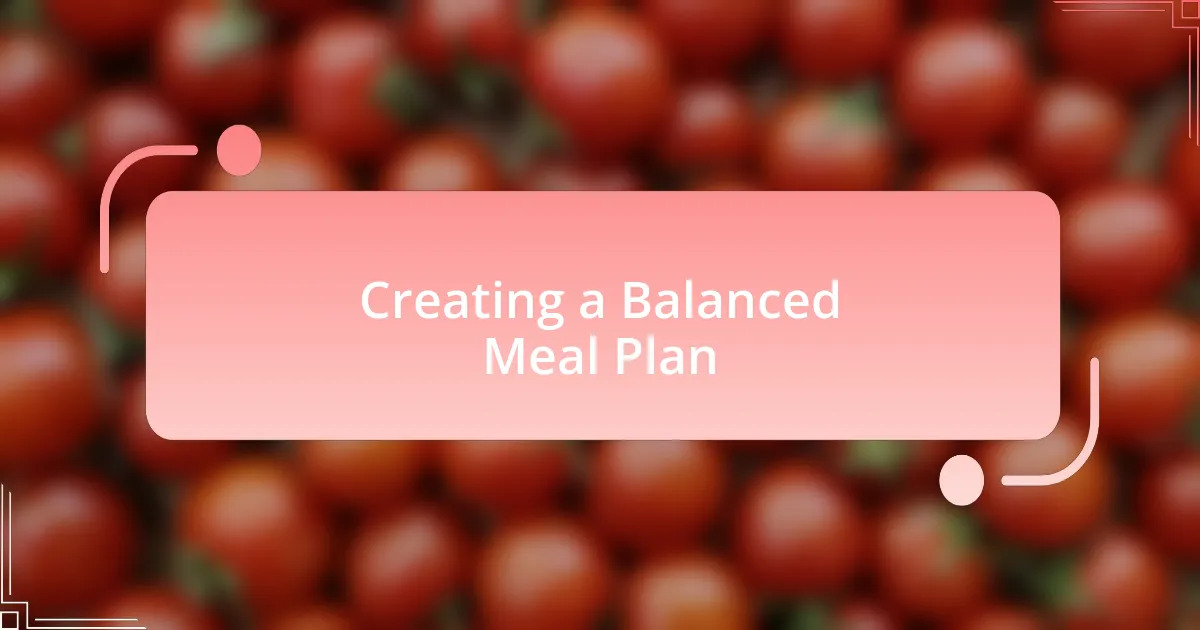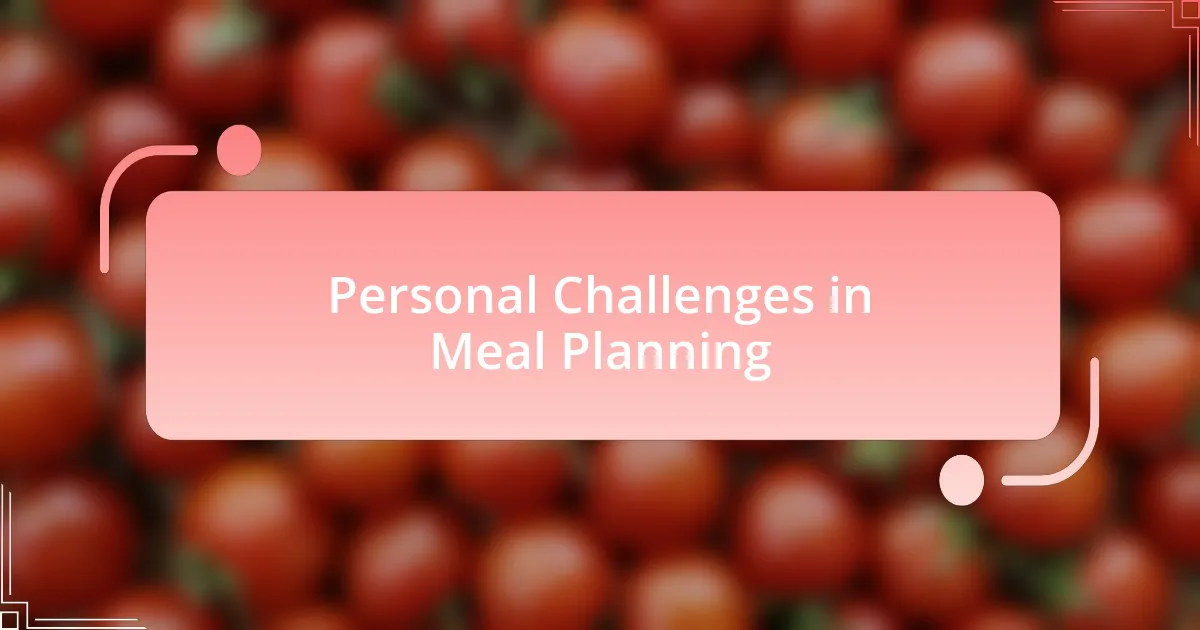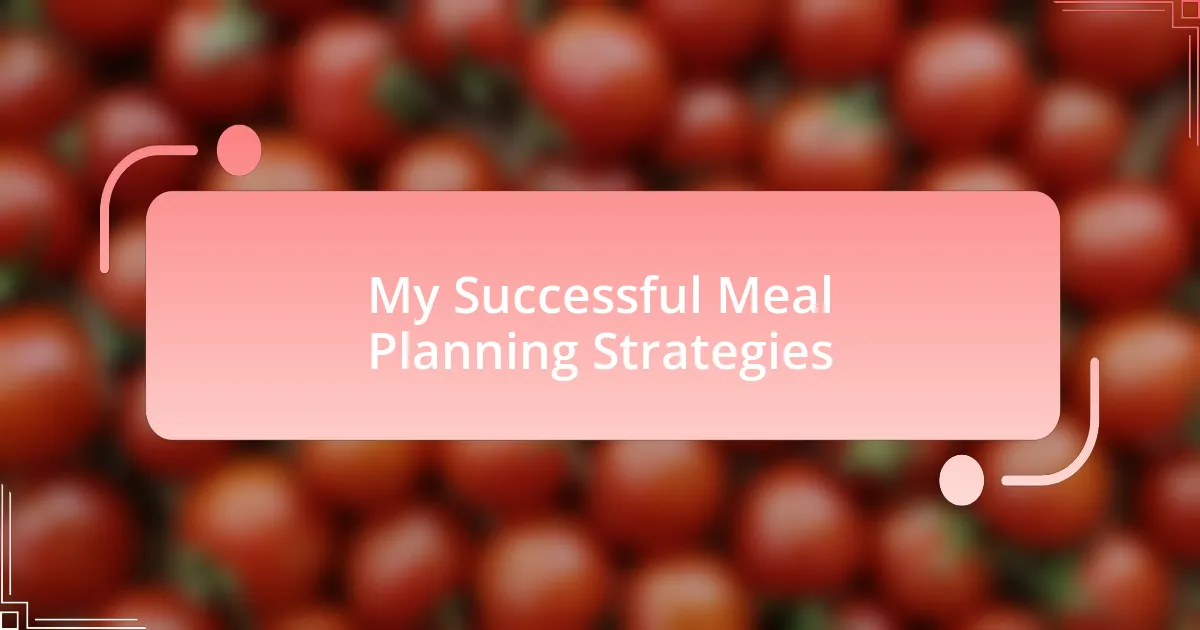Key takeaways:
- Understanding healthy eating involves balancing food groups, practicing portion control, and prioritizing food quality.
- Meal planning reduces stress, improves budgeting, and promotes creativity in cooking.
- Setting realistic health goals keeps motivation high and encourages celebrating small achievements.
- Effective meal planning strategies include creating a weekly menu, batch cooking, and trying new recipes regularly.

Understanding Healthy Eating Principles
When I first delved into healthy eating principles, I discovered that balance is key. This means incorporating a variety of food groups, such as whole grains, lean proteins, fruits, and vegetables, into my meals. Have you ever noticed how your energy levels shift after a balanced meal? I certainly have; it’s like a light switch turning on.
I also learned that portion control plays a crucial role in maintaining a healthy diet. I remember being surprised when I measured my typical serving sizes against recommended amounts. It was eye-opening! Often, we think we’re eating healthy, but if our portions are too large, we could be consuming more calories than realizing.
Lastly, paying attention to food quality made a significant difference for me. Choosing whole, minimally processed foods over refined products was a game-changer. I felt a sense of empowerment when I started reading labels and understanding what I was putting into my body. Isn’t it fascinating how food can be both nourishing and a source of joy if approached mindfully?

Benefits of Meal Planning
Meal planning has transformed my relationship with food in ways I never anticipated. By mapping out my meals for the week, I found a surprising sense of control. It alleviated the anxiety that often comes with last-minute decisions about what to eat. Have you ever experienced the chaos of trying to whip something up after a long day? Meal planning eliminates that stress and creates a more enjoyable cooking experience.
One of the most significant benefits I’ve noticed is the positive impact on my budget. By planning ahead, I could purchase in bulk and reduce food waste. I recall a time when I used to buy groceries without a list, resulting in unnecessary splurges and the dreaded forgotten produce wilting in the fridge. Now, I stick to my plan and often find myself saving money while still enjoying diverse, healthy meals.
Moreover, meal planning encourages creativity in the kitchen. I’ve discovered new recipes and flavor combinations I wouldn’t have tried otherwise. When I dedicate time to think about meals, it feels less like a chore and more like an adventure. My kitchen has become a space for exploration rather than just a place to eat. Isn’t it rewarding to look forward to trying new dishes that are also good for you?

Setting Realistic Health Goals
Setting realistic health goals is crucial for anyone embarking on a journey toward better meal planning. When I first started, I was overly ambitious, aiming to overhaul my diet overnight. I quickly found that setting smaller, achievable goals—like incorporating one new healthy recipe a week—kept me motivated and less overwhelmed. Have you tried tackling too much at once and felt defeated?
Another important aspect is reflecting on what works for you personally. For instance, I realized that my busy lifestyle couldn’t sustain elaborate meal prep every Sunday. Instead, I adapted by choosing simple, quick meals that I could make after work. This approach not only fit my schedule but also kept me excited about cooking instead of dreading the time investment.
Lastly, it’s essential to celebrate your progress, no matter how small. I remember feeling proud when I managed to swap out one processed item for a healthier alternative in my pantry. Recognizing these incremental changes has helped reinforce my commitment to healthier eating. Are you taking the time to acknowledge your own successes on your journey?

Creating a Balanced Meal Plan
Creating a balanced meal plan requires more than just picking healthy foods; it’s about integrating them into your lifestyle in a workable way. I remember when I first tried to include all food groups in each meal. It felt overwhelming. Then, I learned it’s perfectly fine to mix and match throughout the day. For instance, I often rely on a hearty breakfast paired with a light dinner, which makes the whole day feel balanced without the stress. Have you thought about how your meals can flow together?
Another key factor in my journey was the portion sizes. Early on, I struggled with understanding what a ‘serving’ really meant. It took a few weeks of measuring out portions to realize that sometimes less is more. Now, I aim for half my plate to be filled with vegetables, a quarter with lean proteins, and the remaining quarter with whole grains. This simple visual cue helped me make better choices without constantly calculating calories. Have you tried visual portioning to help simplify your meals?
Finally, I found that planning ahead made a world of difference. I typically dedicate an hour on the weekend to outline my meals for the upcoming week. Initially, I felt hesitant, but this has transformed my approach to eating. It not only helps eliminate the last-minute scramble for what to cook but also ensures I include a variety of nutrients throughout the week. Have you ever experienced the freedom that comes from a well-thought-out meal plan?

Tips for Grocery Shopping
When it comes to grocery shopping, I’ve found that making a list is crucial. In the early days, my cart was often filled with impulse buys that derailed my meal plans. Now, I take a moment to reflect on what I need and create a comprehensive list. This not only helps me stick to my budget but also ensures I leave the store with everything necessary for my healthy meals. Have you noticed how a small list can guide your choices?
Another valuable tip is to shop the perimeter of the store. Most grocery stores place fresh produce, lean proteins, and whole grains along the outer aisles. I remember the first time I intentionally avoided the processed aisles; it felt empowering to focus on whole foods instead. This approach not only boosts the nutritional quality of my meals but also makes me feel more connected to what I’m putting into my body. Have you thought about the difference that simple shift in shopping habits can make?
Lastly, I’ve learned the importance of being flexible when shopping. Sometimes, the ingredients I planned to buy are out of stock, but this could lead to delightful surprises! For example, I once discovered a new seasonal vegetable that instantly became a favorite in my meal rotation. Embracing spontaneity while having a plan makes grocery shopping more of an adventure rather than a chore. How do you handle unexpected finds in the produce aisle?

Personal Challenges in Meal Planning
When I first began meal planning, one of my biggest personal challenges was time management. Balancing work, family commitments, and meal prep felt overwhelming, and there were days when it just slipped through the cracks. I distinctly remember one Sunday evening, staring at a mountain of unprepared ingredients, feeling defeated. Have you ever felt like you were fighting against the clock when trying to get dinner on the table?
Another hurdle was dealing with food boredom. I often found myself gravitating towards the same recipes, which led to a lack of excitement around meals. I can’t tell you how many times I made the same stir-fry week after week, justifying it by saying, “It’s healthy and easy!” But eventually, I realized that variety is key to sustaining a healthy eating habit. Have you discovered how refreshing it is to try a new dish that rekindles your love for cooking?
Lastly, overcoming the fear of food waste was a significant challenge for me. I used to purchase fresh ingredients with the best intentions, only to find them wilting away in the fridge days later. One day, after throwing away a bunch of spoiled greens, I had an epiphany about portion control and how to use every component I buy. Now, I focus on meal prepping in a way that maximizes every ingredient, which not only reduces waste but also puts me in a more mindful mindset about my food choices. Can you recall a moment when you realized the value of being resourceful in your kitchen?

My Successful Meal Planning Strategies
One of my most effective meal planning strategies has been creating a detailed weekly menu. Each Sunday, I sit down with a cup of tea and map out meals for the week. This ritual not only gives me clarity on what to cook but also makes grocery shopping so much more efficient. Have you ever noticed how freeing it feels to know exactly what you’ll be eating each day?
Another tactic I’ve embraced is batch cooking. On particularly busy weekends, I devote a few hours to preparing larger portions of multiple dishes. I remember one Saturday when I made a big pot of chili, roasted veggies, and quinoa, dividing everything into containers for the week. This approach has significantly cut down on my weeknight stress. Have you tried cooking in bulk? It can transform your dining experience from frantic to relaxed.
Equally important has been my commitment to trying one new recipe each week. I found that experimenting with different cuisines not only keeps my meals exciting but also broadens my culinary skills. One memorable dinner was a Moroccan tagine that introduced me to unique spices. The moment I took that first bite, I realized how this simple shift could reignite my cooking passion. Have you ever had a dish that made you fall in love with cooking all over again?